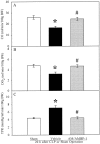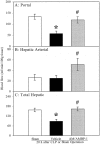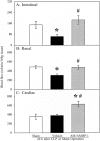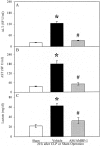Novel approach to prevent the transition from the hyperdynamic phase to the hypodynamic phase of sepsis: role of adrenomedullin and adrenomedullin binding protein-1
- PMID: 12409669
- PMCID: PMC1422621
- DOI: 10.1097/00000658-200211000-00013
Novel approach to prevent the transition from the hyperdynamic phase to the hypodynamic phase of sepsis: role of adrenomedullin and adrenomedullin binding protein-1
Abstract
Objective: To determine whether the combined administration of adrenomedullin and adrenomedullin binding protein-1 (AM/AMBP-1) has any modulatory effects on the cardiovascular response during the progression of sepsis.
Summary background data: Polymicrobial sepsis is characterized by an early, hyperdynamic phase followed by a late, hypodynamic phase. Recent studies have shown that AM, a newly reported potent vasodilator peptide, plays a major role in initiating the hyperdynamic response. Moreover, the reduced vascular responsiveness to AM appears to be responsible for the transition from the hyperdynamic phase to the hypodynamic phase of sepsis. Although the novel AMBP-1 augments AM-mediated action in vitro, it remains unknown whether AM/AMBP-1 maintains vascular responsiveness to AM at the late stage of sepsis.
Methods: Sepsis was induced by cecal ligation and puncture (CLP) in adult male rats. Human AMBP-1 (40 microg/kg body weight) was infused intravenously at the beginning of sepsis for 20 minutes and synthetic AM (12 microg/kg body weight) was continuously administrated for the entire study period using an Alzert micro-osmotic pump, beginning 3 hours before the induction of sepsis. At 20 hours after the onset of sepsis (i.e., the late stage), cardiac output, systemic oxygen delivery, stroke volume, total peripheral resistance, and organ blood flow in the liver, gut, kidneys, and heart were determined using radioactive microspheres. Plasma levels of transaminases (ALT, AST) and lactate were also measured. Additional studies were conducted to determine whether administration of AM alone or AMBP-1 alone alters the cardiovascular response at 20 hours after CLP. In additional rats, the necrotic cecum was excised at 20 hours after CLP following AM/AMBP-1 treatment, the peritoneal cavity irrigated with saline, and the midline incision closed in layers. Survival was then examined for a period of 10 days thereafter.
Results: Administration of AM/AMBP-1 prevented the decrease in the measured systemic and regional hemodynamic parameters at 20 hours after the onset of sepsis. Moreover, AM/AMBP-1 significantly attenuated hepatic damage and the elevation of plasma lactate, and prevented hemoconcentration. Treatment with AM/AMBP-1 reduced the overall 10-day mortality rate from 57% to 7%. Neither AM nor AMBP-1 alone was sufficient to maintain cardiovascular stability at 20 hours after CLP.
Conclusions: Since AM/AMBP-1 delays or even prevents the transition from the hyperdynamic phase to the hypodynamic phase of sepsis, attenuates tissue injury, and decreases sepsis-induced morality, these agents should provide a novel approach for maintaining cardiovascular stability and preventing cell and organ damage during the progression of polymicrobial sepsis.
Figures





Similar articles
-
Mechanisms of the beneficial effect of adrenomedullin and adrenomedullin-binding protein-1 in sepsis: down-regulation of proinflammatory cytokines.Crit Care Med. 2002 Dec;30(12):2729-35. doi: 10.1097/00003246-200212000-00018. Crit Care Med. 2002. PMID: 12483065
-
Adrenomedullin and adrenomedullin binding protein-1 attenuate vascular endothelial cell apoptosis in sepsis.Ann Surg. 2004 Aug;240(2):321-30. doi: 10.1097/01.sla.0000133253.45591.5b. Ann Surg. 2004. PMID: 15273558 Free PMC article.
-
Adrenomedullin and its binding protein attenuate the proinflammatory response after hemorrhage.Crit Care Med. 2005 Feb;33(2):391-8. doi: 10.1097/01.ccm.0000153416.41398.a9. Crit Care Med. 2005. PMID: 15699844
-
Andrenomedullin and cardiovascular responses in sepsis.Peptides. 2001 Nov;22(11):1835-40. doi: 10.1016/s0196-9781(01)00534-4. Peptides. 2001. PMID: 11754970 Review.
-
Adrenomedullin and adrenomedullin binding protein-1: their role in the septic response.J Surg Res. 2003 Feb;109(2):175-81. doi: 10.1016/s0022-4804(02)00086-0. J Surg Res. 2003. PMID: 12643861 Review.
Cited by
-
A hepatic protein, fetuin-A, occupies a protective role in lethal systemic inflammation.PLoS One. 2011 Feb 8;6(2):e16945. doi: 10.1371/journal.pone.0016945. PLoS One. 2011. PMID: 21347455 Free PMC article.
-
Human adrenomedullin combined with human adrenomedullin binding protein-1 is protective in gut ischemia and reperfusion injury in the rat.Regul Pept. 2009 Jan 8;152(1-3):82-7. doi: 10.1016/j.regpep.2008.09.007. Epub 2008 Oct 7. Regul Pept. 2009. PMID: 18948146 Free PMC article.
-
Current trends in inflammatory and immunomodulatory mediators in sepsis.J Leukoc Biol. 2013 Mar;93(3):329-42. doi: 10.1189/jlb.0912437. Epub 2012 Nov 7. J Leukoc Biol. 2013. PMID: 23136259 Free PMC article. Review.
-
Epitope specificity of anti-Adrenomedullin antibodies determines efficacy of mortality reduction in a cecal ligation and puncture mouse model.Intensive Care Med Exp. 2013 Dec;1(1):22. doi: 10.1186/2197-425X-1-3. Epub 2013 Oct 29. Intensive Care Med Exp. 2013. PMID: 26266791 Free PMC article.
-
Application of single cell multiomics points to changes in chromatin accessibility near calcitonin receptor like receptor and a possible role for adrenomedullin in the post-shock lung.Front Med (Lausanne). 2023 Apr 11;10:1003121. doi: 10.3389/fmed.2023.1003121. eCollection 2023. Front Med (Lausanne). 2023. PMID: 37113606 Free PMC article.
References
-
- Bone RC. Sepsis and its complications: the clinical problem. Crit Care Med 1994; 22: S8–S11. - PubMed
-
- Baue AE, Durham R, Faist E. Systemic inflammatory response syndrome (SIRS), multiple organ dysfunction syndrome (MODS), multiple organ failure (MOF): are we winning the battle? Shock 1998; 10: 79–89. - PubMed
-
- Baue AE. Multiple organ failure, multiple organ dysfunction syndrome, and systemic inflammatory response syndrome: Why no magic bullets? Arch Surg 1997; 132: 703–707. - PubMed
-
- Koo DJ, Chaudry IH, Wang P. Mechanism of hepatocellular dysfunction during sepsis: the role of gut-derived norepinephrine. Int J Mol Med 2000; 5: 457–465. - PubMed
-
- Wang P, Chaudry IH. A single-hit model of polymicrobial sepsis: cecal ligation and puncture. Sepsis 1998; 2: 227–233.
Publication types
MeSH terms
Substances
Grants and funding
LinkOut - more resources
Full Text Sources
Other Literature Sources
Medical
Research Materials
Miscellaneous

